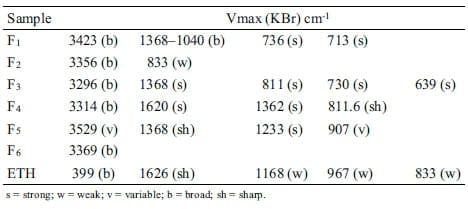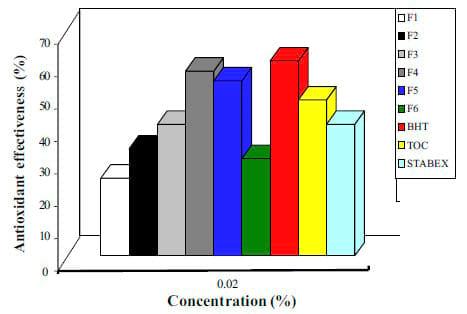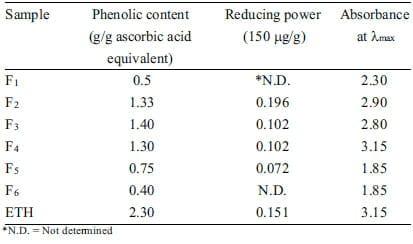Introduction
Exploitation of natural antioxidants, especially from plant sources, has greatly increased in recent years1. This development on application of antioxidants from natural source is favoured by a number of factors, namely (1) safety, since they are part of food man has been eating for thousands of years 2; (2) good carry through effectiveness, since they survive processing operations as found in institutional food preparation; (3) their use is not guided by legislatory rules 3 and (4) their source is renewable. Seed of Garcinia kola possess antioxidant activity superior to some currently used synthetic antioxidants 4. However, the seed and its crude extracts were bitter, an attribute which could limit their application in food systems. The constraint serves as impetus to this study. Attempt made on fractionation and assessment of phytochemical and antioxidant activities of fractionated active components of the seeds of Garcinia kola were reported in this study.
Materials and Methods
Materials: Seeds of Garcinia kola used in this study were obtained from fresh ripe fruits harvested from the parent plant within a cocoa plantation in Ikere-Ekiti, Ekiti State, Nigeria. The seeds were dried at 50°C for 5 days in air oven, thereafter pulverized and packaged for subsequent use. Groundnut oil was obtained from local processor in Ado-Ekiti, Ekiti State, Nigeria. Standard antioxidants used were 2,6-ditert-butyl-4-methyl phenol (BHT) (AldrichChem. Co.), α-tocopherol (α-toc) (Aldrich Chem. Co) and purified extract of Rosemarinus officinalis (stabex). All other chemicals used were of analytical grade.
Solvent extraction of G. kola seeds: Extraction of the seeds of Garcinia kola was done by modifying the method described by Adegoke and Gopalakrishna 5 as follows: an amount of 10 g of finely ground G. kola seeds was extracted with 100 ml of 95% ethanol in Soxhlet extractor for 2 hours. The crude extract was evaporated to remove the solvent and percentage yield of the extract was determined afterwards.
Vacuum liquid chromatography (VLC) fractionation of active antioxidant components of G. kola seed extracts: Fifteen grams of ethanolic crude extract was dissolved in 150 ml of ethanol (95%). This was followed by the addition of 120 g of pre–treated silica gel (Na ethanoate-treated gel). The mixture was mixed till thorough blend was obtained, dried at 80°C in air-oven and milled manually to obtain "pre–absorbed sample". Five grams of the pre-absorbed sample was subjected to VLC on silica gel using a mobile phase (50 ml each) gradient in toluene: ethyl ethanoate: methanol. Fractions were monitored by thin layer chromatography (TLC). Similar fractions were pooled together to produce 6 fractions (F1-6), evaporated to dryness and kept in the dark for subsequent analysis 6.
Characterization of crude and fractionated extracts: Sensory characteristics of crude and fractionated extracts of G. kola seeds were determined subjectively following the procedure of Demooy and Demooy 7. For determination of chemical compounds, standard phytochemical screening procedures as elicited in Trease and Evans 8 were utilized. The total phenols were determined according to the method of Taga et al. 10. The reducing power of crude extract and fractions was determined according to the method of Oyaizu 11.
UV–visible absorption spectra of crude and fractionated extracts at 0.0067% in ethanol were recorded on an UV–visible double beam recording spectrophotometer (Unicam Helios α UV/VIS/ Spectrometer V.2.05 serial No: UVA 072519 year 2000 compliant). The equipment satisfies BSI definition conformity Disc PD 2000 – 1 (with the operational function: intelliscan).
Infrared IR spectra were recorded on a Fourier–transform IR spectrophotometer (Model Bruker IFS 25, Bruker, Karlsruhe, Germany) with the Nujol mull technique in a KBr cell.
Antioxidant incorporation and evaluation of antioxidant activities: The extracts and standard antioxidants (BHT, α- tocopherol, stabex) were incorporated into groundnut oil by direct addition at recommended concentration of 0.02% at 50°C and stirred. Samples treated with G. kola extracts were test samples. Samples treated with BHT, α–tocopherol and stabex (standard antioxidant) were used as positive control and groundnut oil without any additive as negative control.
Antioxidant activities of fractionated extracts were evaluated in treated oil by Schaal oven storage test. The treated (test and positive control) samples were stored in an oven and maintained at a temperature of 63°C. Negative control (sample without antioxidant) was also placed under the same condition of storage as the treated samples. Oxidative stability was monitored by measuring peroxide values at regular interval during the storage period. Decrease in the rate of formation of peroxide was used as a measure of antioxidant activities of control samples, powder and crude and fractionated extracts 2.
Statistical analysis: Data obtained from the evaluation of antioxidant activities at different concentration using changes in peroxide values with time were subjected to statistical analysis, and results were tested for significant differences at 5% level using analysis of variance (ANOVA). The means were separated using Tukey test 9.
Results and Discussion
Sensory characteristics of crude and fractionated extracts: Active components of Garcinia kola seeds were obtained using solvent (ethanol) extraction in Soxhlet apparatus. The active components were separated into 6 fractions as guided by preparatory TLC. Sensory characteristics of G. kola crude and fractionated extracts are shown in Table 1. The crude ethanolic extract (ETH) was a dark brown viscous liquid with lingering bitter taste. Objectionable taste and unappealing colour are some of the characteristicsthat limits the utilization of antioxidants from natural plant materials 12.
The dominating bitter taste of the crude extract may be as a result of alkaloids present in G. kola8, 13. The ethanolic fractionated extracts (F1- F6)obtained were of varying degree of yellowish colour with variable taste profile (Table 1) which could have been as a result of the dominant secondary metabolites (alkaloids, flavonoids, anthraquinones). Interestingly, some fractions (F4 and F5) were light yellow and sun-set yellow (respectively) in colour with non-bitter taste in contrast to dark colour and bitter taste associated with the crude extract. Such fractionated extracts (F4, F5) will be good candidates for preventing lipid peroxidation in food systems if possess antioxidative potentials.
Table 1. Sensory characteristics of crude and fractionated extracts of G. kola seeds.

Phytochemical components in G. kola seeds and crude and fractionated extracts: Phytochemical screening of the seeds and crude extracts revealed the presence of alkaloids, flavonoids and anthraquinones (Table 2).This result is in agreement with earlier reports 8, 14 on the class of secondary chemical compounds present in the seeds of G. kola and plants belonging to the botanical family Guttiferae. Fractions obtained from the crude ethanolic extract were also examined for phytochemical compounds, and the results are shown in Table 2. The determination of dominant secondary metabolites in the fractions will assist in forecasting which fractions will exhibit antioxidant properties. Flavonoids in form of flavonol were dominantly present in F4, and thesame was detected in F5 with trace amount of anthraquinones. Of all polyphenolic compounds, flavonoids and their derivatives have been most implicated with antioxidant activities 8. Relationship between the generalized chemical structure of flavonoids and their antioxidant activities has been thoroughly investigated 15. The effectiveness of flavonoids in retarding lipid oxidation in fatcontaining foods is related to their ability to act as free radical acceptors or as chelators of metal ions. Metal chelation by flavonoids is due to the ortho–dihydroxy (3,4–dihydroxyl) grouping on the B-ring in their chemical structure 16.
While anthraquinones are well known for their laxative properties, flavonoids in addition to their antioxidant properties are also known to exhibit antimicrobial activities 8. In contrast to Sodipo et al.17, saponin was not detected in the crude and fractionated extracts of G. kola seeds. The negative result could be due to seasonal or varietal differences in the seeds of G. kola used.
Table 2. Phytochemical components in the seed and crude and fractionated extracts of G. kola seeds.

UV and IR spectral characteristics of crude and fractionated extracts: Active components of crude ethanolic extract of G. kola seeds were separated into 6 fractions as guided by preparatory TLC. Their UV spectral characteristics in relation to the crude extract as extrapolated from UV-curves (not shown) are presented in Table 3. The crude extract (ETH) had strong absorption at 238 nm and the most potent fractions (F4 and F5) had strong absorptions at 235 and 210 nm, respectively. Strong absorptions (primary and secondary) in the ultraviolet region by the samples are diagnostic feature of unsaturation or unbound electron in the absorbing molecules 18. Free electron is a pre–requisite for antioxidative activity 19. In addition to this high wavelength of maximum absorption (λmax), the samples were characterized with large magnitude of molar extinction coefficient (ε) (Table 3). Dyer 20 reported that magnitude of molar extinction coefficient for a particular absorption is directly proportional to the probability of the particular electronic transitions, that is the more probable a given transition, the larger the extinction coefficient. While both primary and secondary λmax of F4 were higher than that of the standard antioxidant (BHT), the spectroscopic characteristics of BHT were comparable to that of F5.
Table 3. UV-spectral characteristics of crude antioxidants and fractionated ethanolic G. kola seed extracts.
Functional groups were assigned to IR–absorption peaks using functional group-frequency chart adapted from Silverstain et al. 21. Peaks of diagnostic value (Table 4) as extrapolated from IR–curves (not shown) were identified and selected based on frequency – antioxidant functional group potentials. The functional groups were: phenolic hydroxyl group (≈3390 cm-1), unsaturation/free–electron potential (1600–1670 cm-1) and nuclei aromaticity (800-900 cm-1). The presence of peaks in the region and their intensity are indices of antioxidative potentials of the crude and fractionated extracts. These properties were more pronounced in ETH, F4 and F5. Added to this, the functional groups were the building blocks of antioxidant compounds.
Table 4. IR–spectral characteristics of the crude and fractionated extracts of G. kola seeds.

Antioxidant activities of fractionated extracts in groundnut oil: Antioxidant activities of fractions obtained from the crude ethanolic extract and standard antioxidants (BHT, α-tocopherol, stabex) in groundnut oil atrecommended concentration of 20 mg/100 g were evaluated. The peroxide values of the groundnut oil determined when the samples were fresh and periodically at 7 days interval for 35 days are shown in Fig. 1. Fractions F4 and F5, yellow, non-bitter taste extracts, had the highest antioxidant effectiveness of 58.44% and 55.34% respectively (Fig. 2). The dominant secondary metabolites in the fractions as shown by phytochemical assessment (Table 2) are flavonoids (flavonol) and anthraquinones. Flavonoids is a class of polyphenols with effective antioxidant activities 22. Some anthraquinones have been reported to posses antioxidant activities 23. Fraction (F2), where alkaloids are dominant, had low (33.8%)antioxidant effectiveness compared to activities of F4 (AE 58.44%) and F5 (AE 55.34%). This result suggests that alkaloids are not the dominant active components responsible for antioxidant activities of Garcinia kola seeds. In addition, there was no fractionated extract with antioxidant effectiveness higher thanthe antioxidant effectiveness (ETH 78.5%) of crude extracts (Fig. 2). It is then suggested that the active components might act in synergism with each other or with other components in the extracts 24. However, the antioxidant effectiveness of yellowish non–bitter fractionated extracts (F4 and F5) were comparable to BHT, α−tocopherol and stabex, the standard antioxidants used (Table 5). The results indicated a comparable (p = 0.05) potency of fractionated extracts (F4 and F5) to the reference antioxidant (BHT) and superior to α-tocopherol and stabex. Fractionation of ethanolic extract using VLC yielded extracts void of bitter taste with characteristic golden yellow colour associated with activities comparable to standard antioxidants (BHT, α-tocopherol, stabex).
Figure 1. Antioxidant activity of fractioned extracts of the G. kola seeds and standard antioxidant in groundnut oil (20 mg/100 g).
Figure 2. Percentage antioxidant effectiveness of fractionated extracts of G. kola seeds and standard antioxidants at 0.02% concentration.
Table 5. Antioxidant activities of fractionated extracts of G. kola seeds and standard antioxidants in stabilization of groundnut oil.

Relationship between phenolic content, reducing power and absorbance of antioxidant crude and fractionated extracts: Phenolic content, reducing power and absorbance at λmax of crude and ethanolic fractionated extracts are shown in Table 6. Correlation (r = 0.980) exists between phenolic content and reducing power. This result suggests that the mode of antioxidative action of the phenolics in the G. kola seeds is more of electron transfer than of resonance stability by phenyl moiety. Similarly, it appears there was slight relationship (r = 0.700) between total phenolic content and λmax. This implies that the phenolic compounds in the crude and fractionated extracts are of variable qualities. A procedure for assessing phenol antioxidant index (PAOXI), a combined measure of quantity and quality of phenolic antioxidants, has been described by Vinson et al.25.
Table 6. Phenolic content, reducing power and absorbance at λmax of crude and fractionated extracts of G. kola seeds.
Conclusions
Fractionation of ethanolic dark brown bitter viscous crude extract of the Garcinia kola seeds yielded yellow, non-bitter extracts with antioxidant activities comparable to currently used synthetic antioxidant. The active components can be used to extend shelf life of oxidizable food products.
Acknowledgement
The authors wish to thank Dr. Kunle Idowu, the Dept. of Pharmaceutical Chemistry, Faculty of Pharmacy, University of Ibadan, Oyo State, Nigeria, for useful suggestion on laboratory works.
References
1Jayaprakasha, G. K. and Jaganmohan, Rao, L. 2000. Phenolic constituents from lichen Parmotrema stuppeum (Nyl.) Hale and their antoxidant activity. Z. Naturforsch. 55C:1018–1022.
2Chang, S. S., Ostric-Matijasevic, B., Aseih, O. A. and Huang, C. L. 1977. Natural antioxidant from rosemary and sage. J. Food Sci. 42:1102- 1106.
3Matthaus, B. 2002. Antioxidant activity of extracts obtained from residues of different oil seeds. J. Agric. Food Chem. 50:3444–3452.
4Daramola, B. 2005. Nutrient Profile, Antioxidant and Antimicrobial Propertities of the Active Components of Garcinia kola. Ph.D. thesis, Department of Food Technology, Univestity of Ibadan, Ibadan, Oyo State, Nigeria.
5Adegoke, G. O. and Gopalakrishna, A. G. 1998. Extraction and identification of antioxidant from the spice Aframomum danielli (Family Zingiberaceae). J. Amer. Oil Chem. Soc. 75:1047- 1052.
6Odukoya, O. A., Houghton, P. J. and Raman, A. 1999. Lipoxygenase inhibitors in the seeds of Aframomum danielli K. Schum (Zingiberaceae). Phytomedicine 6(4):251- 256.
7Demooy, B. E. and Demooy, C. J. 1990. Evaluation of cooking time and quality of seven diverse cowpea (Vigna unguiculata) varieties. Int. J. Food Sci. and Tech. 25:202–212.
8Trease, G. E. and Evans, W. C. 2002. Pharmacognosy. 15th edn. Harcourt Publishers, Edinburgh, UK.
9 Snedecor, G.W. 1956. Statistical Methods. 5th edn. Iowa State College Press.
10Taga, M. S., Miller, E. E. and Pratt, D. E. 1984. Chia seeds as a source of natural lipid antioxidants. J. Am. Oil Chem. Soc. 61:928-930.
11Oyaizu, M. 1986. Studies on extracts of browning reaction: Antioxidative activities of extracts of browning reactions prepared from glucosamine. Japan J. Nutrition 44:307-315.
12Smith, J. 1993. Food Additives. Users Handbook. Blackie Academic and Professional, London, pp. 1-6.
13Braide, V. B. 1988. Antispasmodic extracts from seeds of Garcinia kola. Fitoterapia 60:92-125.
14Iwu, M. M. 1985. Antihepatotoxic constituent of Garcinia kola seed. Experimentia 41:699 -700.
15Cuvelier, M. E., Richard, H. and Berset, C. 1992. Comparison of the antioxidative activity of some acid-phenols: Structure–activity relationship. Biosci. Biotech. Biochem. 56(2):324–324.
16Shahidi, F., Wanasundara, P. K. and Hong, C. 1992. Antioxidant Activity of Phenolic Compounds in Meat Model. Chemical Society, Washington DC, pp. 106–108.
17Sodipo, O. A., Akanji, M. A., Kolawole, F. B. and Odotuga, A. A. 1991. Saponin is the active antifungal principle in Garcinia kola Heckel seeds. Bioscience Research Comm. 3(1):51-57.
18Shriner, R. L., Fuson, R. C., Curtin, D. Y. and Morrill, T. C. 1979. The Systematic Identification of Organic Compounds: A Laboratory Manual. 6th edn. John Wiley, New York, pp. 416–430.
19Giese, J. 1996. Antioxidants: Tools for preventing lipid oxidation. Food Technol. 50(1):73-81.
20Dyer, R. J. 1987. Applications of Absorption Spectroscopy of Organic Compounds. Georgia Institute of Technology, Prentice-Hall of India Private Limited, New Delhi, pp. 5-21.
21Silverstein, R. M., Bassler, G. C. and Morrill, T. C. 1981. Spectrometric Identification of Organic Compounds. 4th edn. John Wiley and Sons, New York, USA, pp. 166–170.
22Foti, M. and Ruberto, G. 2001. Kinetic solvent effects on phenolic antioxidants determined by spectrophotometric measurements. J. Agric. Food Chem. 49:342-348.
23Malterud, K. E., Farbrot, T. L., Huse, A. E. and Sund, R. B. 1993. Antioxidant and radical scavenging effects of anthraquinones and anthrones. Pharmacology 47:77-85.
24Amarowic, Z. R., Wanasundara, U. N., Kramac, M. and Sahidi, F. 1996. Antioxidant activity of ethanolic extract of mustard seed. Nahrung 40(5):261-265.
25Vinson, A. J., Hao, Y., Su, X. and Zubik, L. 1998. Phenol antioxidant quantity and quality in foods: Vegetables. J. Agric. Chem. 46:3630- 3634.
This article was originally published in the Journal of Food, Agriculture & Environment Vol.7 (1) : 2 7 - 3 0 . 2 0 0 9 www.world-food.net. Engormix.com thanks for this contribution.















.jpg&w=3840&q=75)